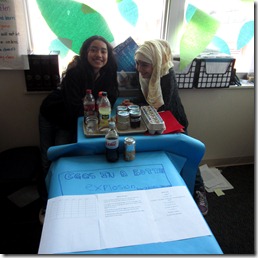Guest post: The 21st century science project
As we prepare for the Microsoft Partners in Learning Global Forum (#PiLGF) in Prague, Czech Republic, I will be featuring guest posts from “Team USA” (the 16 teachers who will be representing the U.S. at this amazing professional learning experience). Today’s post is from educator Jamie Ewing and his student’s with their eLabs: Science in the Cloud project, which won 1st place in the Collaboration category at the Partners in Learning 2012 US Forum. Jamie is a fifth grade teacher at Mount View Elementary, Seattle, WA.
What SHOULD it look like with 21st Century Learning? DIGITAL! 
eLABs: Science in the Cloud takes students there and beyond. Spending valuable time doing amazing science work only to end up cutting out construction paper and gluing it on cardboard is atrocious in this age of technology!
Students begin by exploring the state standards in student friendly language for Earth Systems/Ecology and then ‘Mind Storming’ in small teams to create science experiments based on these standards. Teams design their experiment using the Scientific Method as their guide. It’s important that teams work together to assign roles in the team making sure that each member shares in the responsibilities of setting up that experiment and collecting data. Finished experiments will be presented in a virtual world instead of the normal tri-fold ‘science fair’ model.
But the fun (and learning!) has only started.
The two most important words for eLABs? Science + Blogs.
Science blogs are set up for experiment. Teams will blog about their experiment, what they are observing day to day, and report about their final results. But since running science experiments doesn’t leave time to see what other teams are doing, students interact with other blogs ask questions or make comments. Students can use social media to find scientists, biologist, ecologists, gardeners…well you get the picture…to find experts to match up with projects and teams to ask questions, make comments, and get involved. THIS BLEW MY STUDENTS MINDS! To find out that people outside the classroom were interested, really  interested, in their work was powerful. As one of my students said, “It made me feel smart!”
interested, in their work was powerful. As one of my students said, “It made me feel smart!”
Downtime? The very nature of science experiments creates a lot of down time. This part of the project is where things start to make sense and connections are made. Each member creates a PowerPoint presentation and a Scratch programmed animated presentation. Use PowerPoint to create an instructional ‘video’ that each group up-loads to our class website to share with the world. The presentation is only about running the experiment not findings so that other people could take the information and try it themselves (here are some tutorials for using PowerPoint in the classroom).
The Scratch project is a programmed animated video that shows each students (animated as a scientist avatar) walking the viewer through their entire experiment, even testing the viewer at the end. These projects are then uploaded to the Scratch website to be judged.
To finish the whole project off, teams take their findings and design an ecology-based project that they could bring to their community as a way to help the community’s environment and improve their surroundings. Community interactions will be in blog form or with Skype, if possible, to connect our students to community leaders.
While each of these projects plays an important part to the whole process for my students they are not set in stone. Putting together the pieces that can be easily manageable is the key to eLABs success. The interactions within blogging are the most powerful piece. It allows students to express things that they might not do so in the classroom. Blogging allows students to have conversations with other students and beyond. I use EduBlogs as it is a safe, manageable blog service that is free. If the blogging seems daunting (I had 12 going all at once), try having only one and post questions that students can then go on and write reflections.
Young students could benefit with using Skype for the Classroom which allows you to bring the scientist into the classroom. Scratch is a powerful tool but will take a little practice. Try video science presentations. The ideas for a digital eLAB science experience are endless.
The power of this project is not the science but the experiences the student create in science and collaborating with each other to share their science ides. The power is in the engagement that social media brings to broaden the learning from all corners of the globe (my students collected information from as far away as Luxemburg). eLABs puts the power in the hands of the students and THAT is power!
Jamie Ewing @mrewingteach
5th grade teacher
Mount View Elementary, Seattle, WA
See related posts:
- Guest post: On A Mission to Stop Bullying with the Canastota Apprentice
- Guest post: “Don’t be afraid to be awesome today”
- Finalists for the Microsoft Partners in Learning 2012 US Forum
- Students Impact Change in Times of Crisis
- Educator Combines Biology and Gaming with Kinect to Engage Students and the Community
- Delivering Success through Technology for Students with Disabilities
